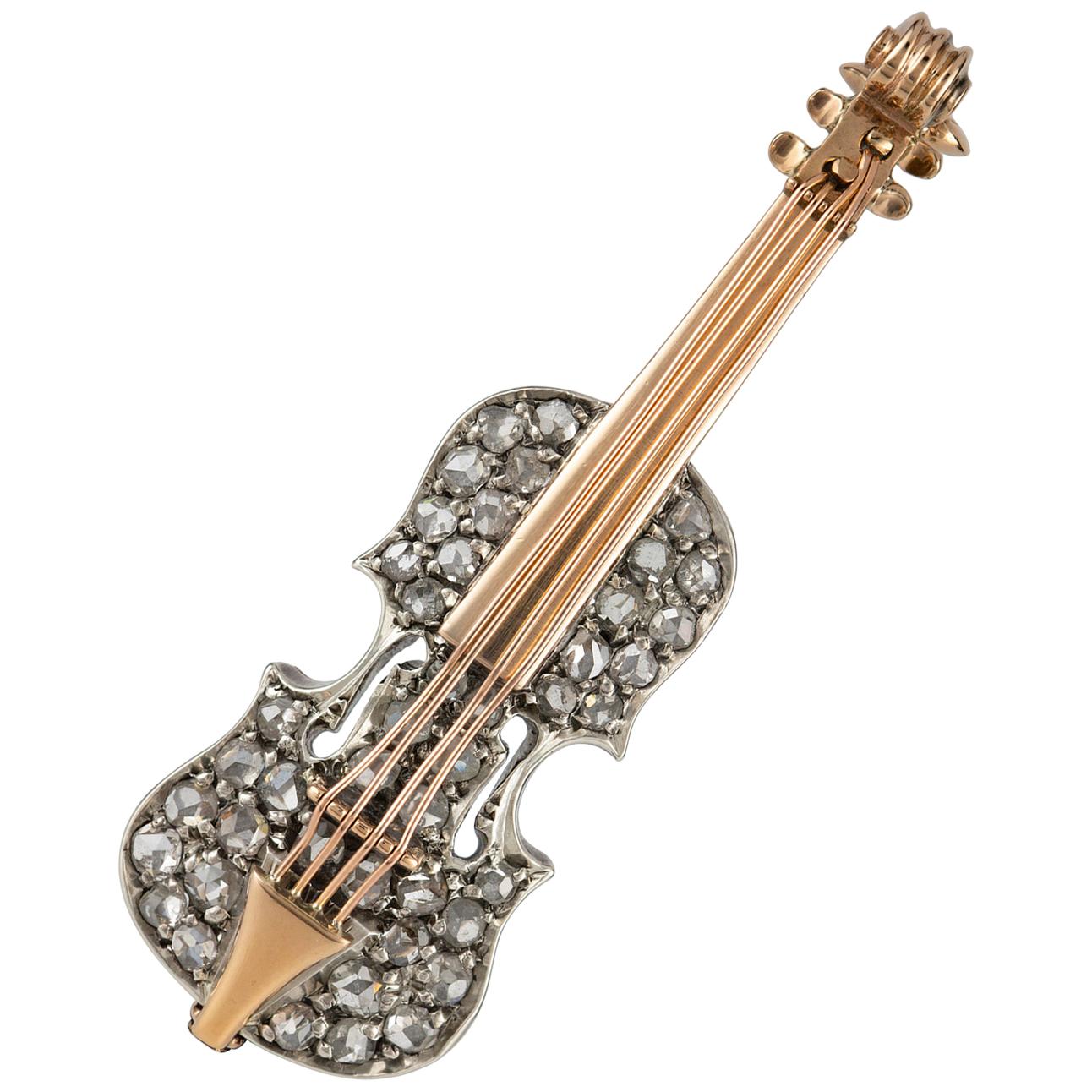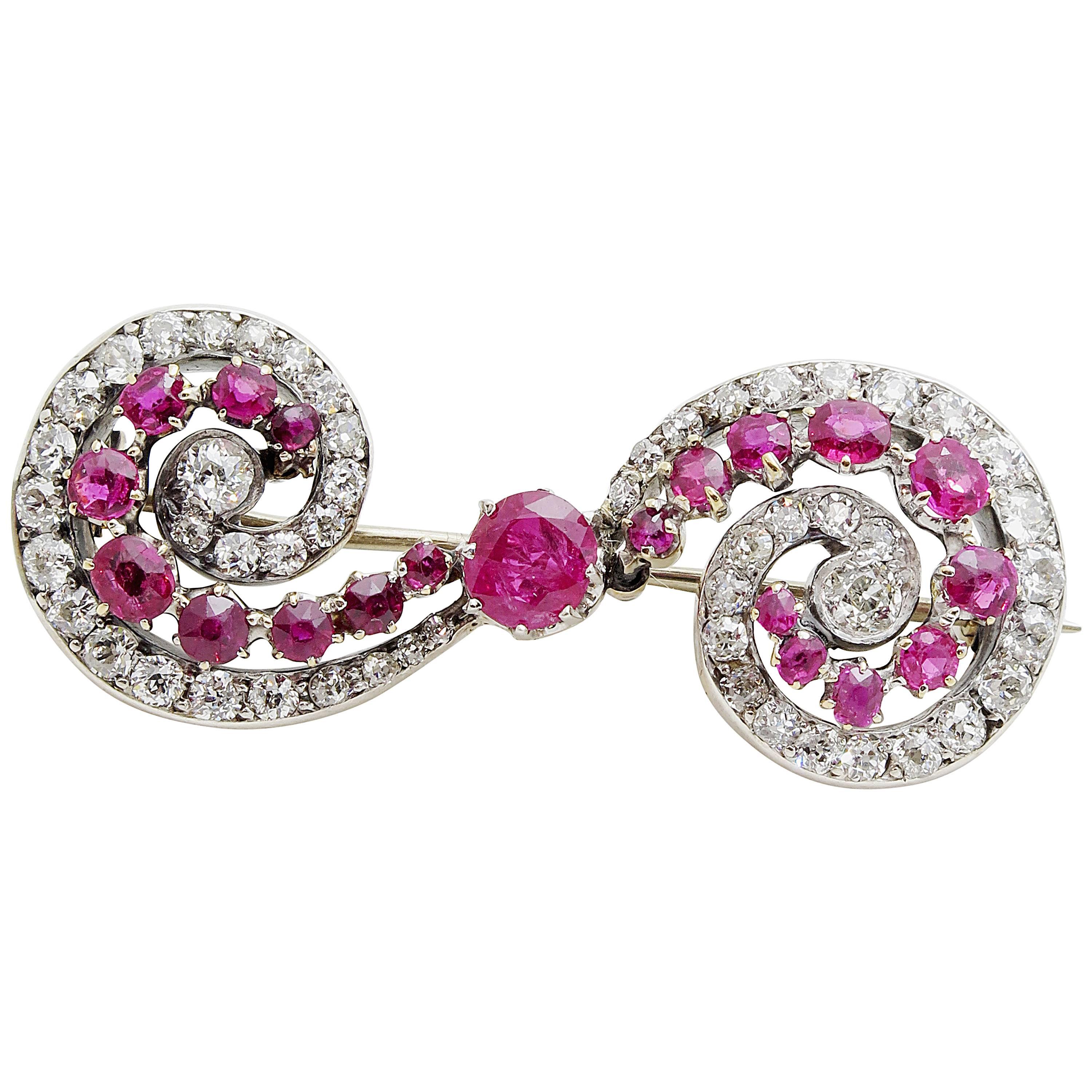Items Similar to Late 19th-Century Silver and Opal Cape Clasp by Louis Wièse
Video Loading
Want more images or videos?
Request additional images or videos from the seller
1 of 6
Late 19th-Century Silver and Opal Cape Clasp by Louis Wièse
About the Item
Louis Wièse
Cape Clasp
France (Paris), c. 1890
Silver, opals
Weight 102.8 gr.; Length 22.23 cm.; individual clasp diameter(s) c. 44 mm.
Two openwork roundels in relief show a Chinese dragon head in cast and chased silver, entwined by a serpentine body with bird’s feet and talons. The eyes are formed of opal cabochons. Both roundels are joined by a wire loop and hook as clasp and eight chain links of twisted wire with intersecting plain loops. Traces of gilt remain. On the reverse along the edge of both roundels is the maker’s mark “WIESE” for Louis Wièse.
This beguiling cloak clasp stands out as highly unusual in Louis Wièse’s jewelry. The face of a dragon, its opal eyes glimmering, emerges out of the center of each medallion. A pug nose sits atop of mustache-shaped mouth, below which appear tiny fangs. Although the intricate body and tail of the dragon wraps around the face on each example, they are not identical; the dragon’s tail sits atop the face on the left clasp and below it on the right one. Ferocious these dragons are not; if anything, they arouse amusement.
Wièse’s attraction to Gothic art must have inspired the form of the clasp, which harkens back to medieval fashions. However, the dragons reflect the fascination with “orientalism” so prevalent in the arts of Europe after Japan opened its doors to international trade in 1854. Japanese woodcuts and applied arts were shown at the International Exhibition in London in 1862 and then in the 1870s in Paris, Vienna, and Philadelphia. Known as “Japonisme,” the movement took its inspiration from both China and Japan. Samuel Bing (1838–1905), an art dealer from Hamburg, who opened a shop in Paris and founded in 1888 the journal Le Japon Artistique was a key figure in introducing objets d’arts from Japan, China, and other Asian countries to a broader public.
The Chinese dragon, in comparison to the European, has the body of a snake, talons of an eagle, antlers of a deer, and eyes of a demon, like here. In Chinese folklore, the dragon symbolizes wisdom, power, and luck and is believed to protect against all evil. Japan took the dragon motif from China where it symbolizes a successful life.
Literature: compare Mauriès and Possémé 2017, pp. 118–119 (an identical cloak clasp by Louis Wièse in the Musée des Arts Décoratifs, Paris); exh. cat. French Jewellery of the Nineteenth Century, 2001, no. 79 (for the same motif on a gold brooch); Weisberg 1986 (on Asian dragons); and Wichmann 1981, pp. 336–339 (on Bing).
- Creator:Louis Wièse
- Metal:Silver
- Stone:Opal
- Stone Cut:Cabochon
- Weight:102.8 g
- Style:Gothic Revival
- Place of Origin:France
- Period:1890-1899
- Date of Manufacture:1890
- Condition:Wear consistent with age and use.
- Seller Location:Chicago, IL
- Reference Number:
About the Seller
5.0
Vetted Seller
These experienced sellers undergo a comprehensive evaluation by our team of in-house experts.
Established in 1991
1stDibs seller since 2021
5 sales on 1stDibs
Typical response time: 13 hours
- ShippingRetrieving quote...Ships From: Chicago, IL
- Return PolicyA return for this item may be initiated within 3 days of delivery.
More From This SellerView All
- Gothic Revival Gold Ring with Joan of Arc by Louis Wièse, Late 19th CenturyLocated in Chicago, ILJoan of Arc Ring by Louis Wièse (1852-1930) France, c. 1890 Gold Weight 9.3 gr.; Circumference 56.45 mm.; US size 7 3/4; UK size P ½ Cast and chased openwork gold ring with square section hoop, grooved on the lower half and forked at the shoulder to form a triangular frame for a Gothic trefoil...Category
Antique 1890s French Gothic Revival Cocktail Rings
MaterialsGold
- Late 19th-Century Enameled Brooch with Diamonds by FalizeBy FalizeLocated in Chicago, ILAlexis Falize Brooch with depiction of Renaissance Lady France (Paris), c. after 1894 Gold, silver, enamel, diamonds Weight 10.7 gr.; Width 43.6 mm.; Height 22.3 mm. Gold rectangu...Category
Antique 1890s French Renaissance Revival Brooches
MaterialsDiamond, Gold, Silver, Enamel, 18k Gold
- 19th century Water Squirt Ring in Silver and Gold with Rock CrystalLocated in Chicago, ILSquirt Ring West European, 1800-1900 Silver, gold, rock crystal Weight 9.4 gr.; circumference 60.38 mm.; cylinder length 41.2 mm US size 9 ¼ ; UK size S ¼ Fascinating nineteenth century party piece, incorporating an elegant and sparkling ring Description: Squirt ring made of a hollow silver cylinder with four ornamental bands and a cap with plunger. This holds the liquid, and when the plunger is pulled out and pushed back in the squirt mechanism is triggered. At the other end is a hollow ring through which the liquid flows and then squirts out of a small hole on the band next to the gemstone. The gold ring, angled to the cylinder, has a tubular hoop and a gold round-shaped cup bezel with a silver-set, facetted rock crystal gemstone. The ring is fully functionable. The cylinder lies concealed in the palm of the hand. Punched on the cylinder is a swan, the French guarantee mark for the fineness of silver on items of unknown origin (in use from 1893-1970). Along the gold hoop of the ring are four indistinct hallmarks: a helmeted head (?), two rectangular punch marks, one with lower case ‘g’ in the corner, and traces of two illegible punches. Provenance: Yves Brasseur (26 February—11 August 2005), Ghent, Belgium, a collector of rings who was a Belgian fencer of Olympic stature, having competed in this sport in the Olympics in the 1960s. Literature: The earliest account of a squirt ring dates to about 1770 with the description of a diplomatic incident at the Court of Frederick the Great. The French ambassador M. de Guines belonged to the diplomatic corps in Berlin, the capital of the Prussian Empire. His pompous behavior was widely mocked. Prince Dolgorouki, the Russian ambassador was invited to a gala dinner as a guest of honor with his newly wed bride. She was seated next to the French ambassador whom she squirted with water from a mechanism concealed in the palm of her hand, when he was admiring her jewel. He vowed he would throw a glass of water at her if she continued. The ambassador’s wife ignored his warning, and he in fact put his threat into effect. The guests at the dinner were obliged to keep a discreet silence surrounding this embarrassing occurrence. The fashion for such squirt rings appears to have continued into the nineteenth century, although few examples are known. The designs and materials vary: bronze ring with mask of Silenus in the Victoria and Albert Museum. Silenus, the god of wine-making and drunkenness, appears again on a squirt ring in form of a garnet cameo...Category
Antique 19th Century European Solitaire Rings
MaterialsRock Crystal, Quartz, Gold, Silver
- Renaissance Portrait Cameo of Emperor Vespasian in a Gold BroochLocated in Chicago, ILPortrait Cameo of Emperor Vespasian in a Gold Brooch Agate, gold Italy?, 16th century Weight 10.2 gr.; Dimensions 48.7 × 39 mm. Description: Three-layered agate cameo (black-white-...Category
Antique 16th Century Italian Brooches
MaterialsAgate, Gold
- Ancient Gold Roman Ring with Bust of Tyche 'circa late 1st - 2nd century CE'Located in Chicago, ILRing with Bust of Tyche Roman, late 1st century - 2nd Century AD Gold Weight 4.4 gr.; Circumference 43.45 mm.; US size 2 ¾ ; UK size E ½ Miniature sculpture in ring form of the Gree...Category
Antique 15th Century and Earlier European Classical Roman Cocktail Rings
MaterialsGold
- Antique Silver Twisted Band RingLocated in Chicago, ILTwisted Band Ring Silver England, 15th-16th century Weight 2.9 gr.; circumference 51.9 mm.; US size 6, UK size M The wide silver hoop is slightly rounded inside with an original solder point and twisted and beaded on the outer side. Between one of the grooves on the outer side are two out-of-place beads where a punch was apparently hammered in the wrong position. The ring is in good wearable condition. This beautiful, wearable ring consists of a spiral-grooved hoop. The twisting, fluted band is typical of medieval iconographic rings...Category
Antique 16th Century English Medieval Band Rings
MaterialsSilver
You May Also Like
- Late 19th Century Diamond BroochLocated in London, GBA late nineteenth century diamond brooch, finely modelled in the form of a violin, the body encrusted with rose-cut diamonds and the strings, neck and head in rose gold, French Impor...Category
Antique 1890s French Late Victorian Brooches
MaterialsDiamond, 14k Gold, 9k Gold, Rose Gold, Silver
- Late 19th Century Fly BroochLocated in London, GBA late 19th century fly brooch, the bee set with a dementoid garnet, a ruby eye, diamond wings and a pearl body, set in silver and gold, with a further pear...Category
Antique 19th Century Unknown Late Victorian Brooches
MaterialsAmazonite, Diamond, Garnet, Ruby, Yellow Gold, Silver
- Victorian Ruby and Diamond Brooch, Late 19th CenturyLocated in Austin, TXA wonderful late 19th century Victorian ruby and diamond scroll or swirl brooch set in silver topped 18k gold. The small brooch of impeccable design, featuring two opposing swirl or...Category
Antique 1890s Unknown Victorian Brooches
MaterialsDiamond, Ruby, 18k Gold, Silver
- Lyra Diamonds Brooch, Late 19th CenturyLocated in Sežana, SILyra-shaped brooch – Made in Italy – Late 19th century. The brooch is set with 25 rose cut natural diamonds. The main body is made of gold, while the upper part and settings are in...Category
Antique Late 19th Century Italian Classical Roman Brooches
MaterialsDiamond, Gold, Silver
- Late 19th Century Mourning BroochLocated in Dallas, TX9 karat yellow gold brooch with black Taille d'Epergne. The central medallion rotates to show 2 views of the beautifully braided hair work.Category
Antique Late 19th Century Victorian Brooches
Materials9k Gold, Yellow Gold
- Late 19th Century Butterfly BroochLocated in London, GBA Late 19th Century butterfly brooch. Set with approximately 7 carats of cushion shape, old and brilliant-cut diamonds with sapphire and rubies mounted in silver on top of gold. Leng...Category
Antique 19th Century Brooches
MaterialsDiamond, Ruby, Blue Sapphire
Recently Viewed
View AllMore Ways To Browse
French Wire Bird
Cat Brooches
S Shaped Hooks
Antique Silver Cat
Gold Cat Brooch
Antique Dragon Jewelry
Dragon Brooches
Dragon Brooch
Antique Medieval Jewelry
Antique Demon
Antique Bird Brooch
Antique Bird Brooches
Links Of London Gold
Gold Snake Brooch
Antique Opal Brooches
Opal Brooch Antique
Antique Opal Brooch
Antique Oriental Jewelry





